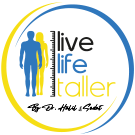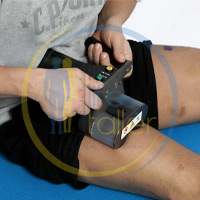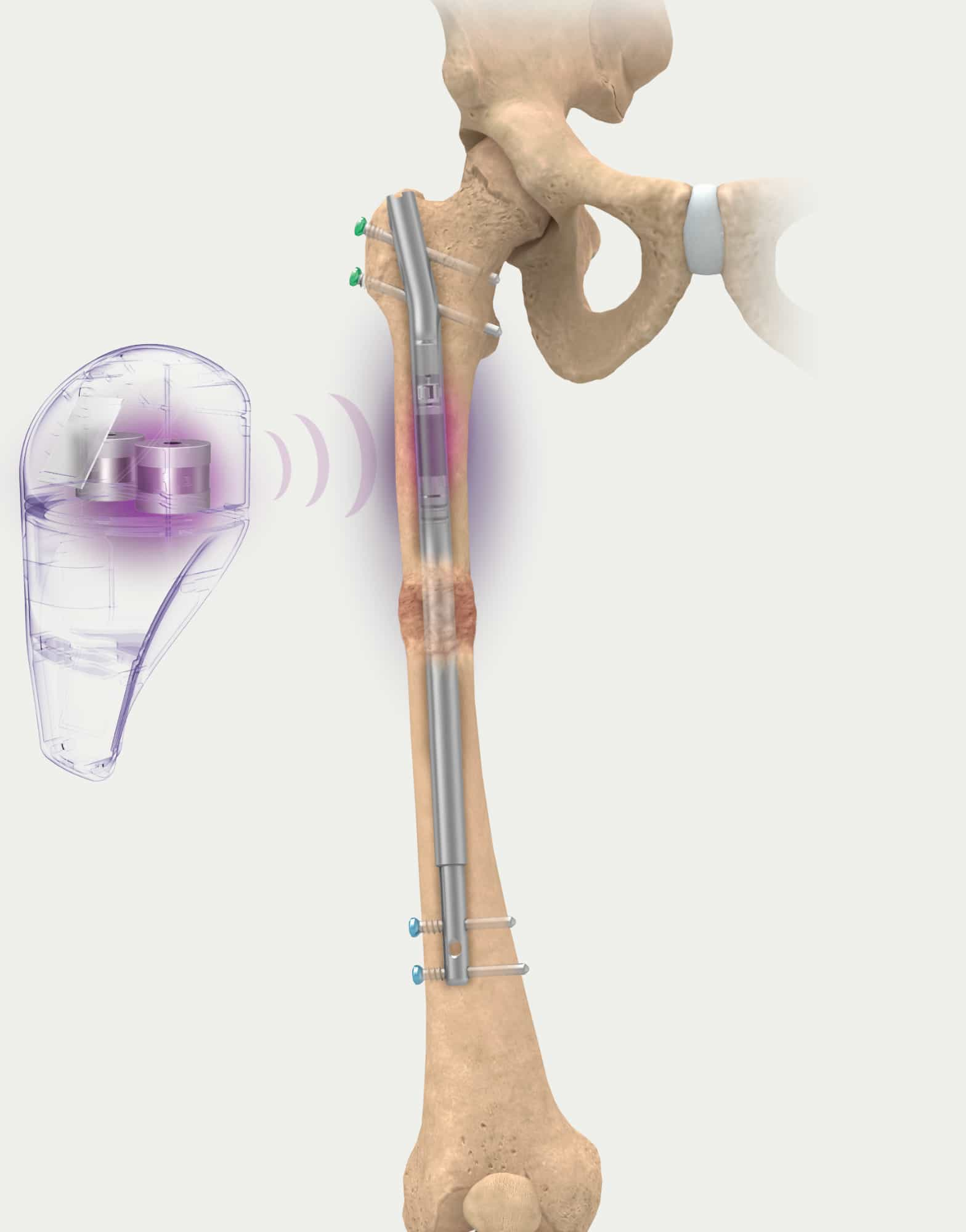
What is The Precice 2 Method ?
The PRECICE 2 intramedullary is a highly modern system for Limb lengthening (also known as bone lengthening)
What is Internal Limb Lengthening?
The lengthening device is inserted inside the bone. The device has a small magnetic motor inside it. When the motor is activated by an External Remote Controller (ERC), the device slowly lengthens. This causes the bone to slowly lengthen.
Previously, the only way to lengthen a bone was to apply a metal scaffold to the leg called an external fixator. External fixators are metal devices that are attached to the bones with special threaded pins or wires. These threaded pins or wires pass through the skin and muscles and are inserted into the bone. The majority of the device is outside of the body.
Please visit Limb Lengthening: The Process for general information about limb lengthening.
How is Precice 2 Method surgery performed
The Precice 2 Limb Lengthening System (NuVasive Specialized Orthopedics, San Diego, CA) consists of a telescoping metal rod (called a lengthening nail) with a magnetic motor inside of it. The intramedullary nail is inserted through a small incision into the bone canal (where the bone marrow is found).
How does the Precice 2 method work? / How does the process proceed in the Precice 2 Method?
The patient is given a special device called an External Remote Controller (ERC) that is used to make the Precice nail slowly lengthen. The ERC has a magnet inside it that rotates. When the ERC is placed against the leg or arm and turned on, the movement of the magnet inside the ERC causes the magnetic motor inside the Precice to slowly lengthen. When the Precice lengthens, the bone also lengthens.
What are the advantages of Precice 2 method?
- Minimal risk of infection
- Minimal scars
- Better joint mobility
- Greatest possible comfort
- Not restricted with clothing
- Sleeping positions are not restricted
What are the disadvantages of Precice 2 method?
- Not fully loadable during treatment
- No intervention from the outside, possible in case of problems with intramedullary nail
- Anaesthesia incidents
- Thrombosis risk
- Nails may bend and/or break under high pressure, requiring further surgery
Risk and Complications
- Nonunion of bone healing
- Early/premature bone healing
- Skin infection
- Bone infection
What is the Precice Stryde Lengthening System?
The Precice Stryde nail operates like the Precice nail. The main difference is that the Precice Stryde nail is made of steel alloy instead of titanium. As a result, the Precice Stryde nail allows for more weight bearing, even in the early stages of treatment. This enables patients to return to daily activities sooner. To be on the safe side, we still recommend that our patients lengthening with the Precice Stryde system use crutches.
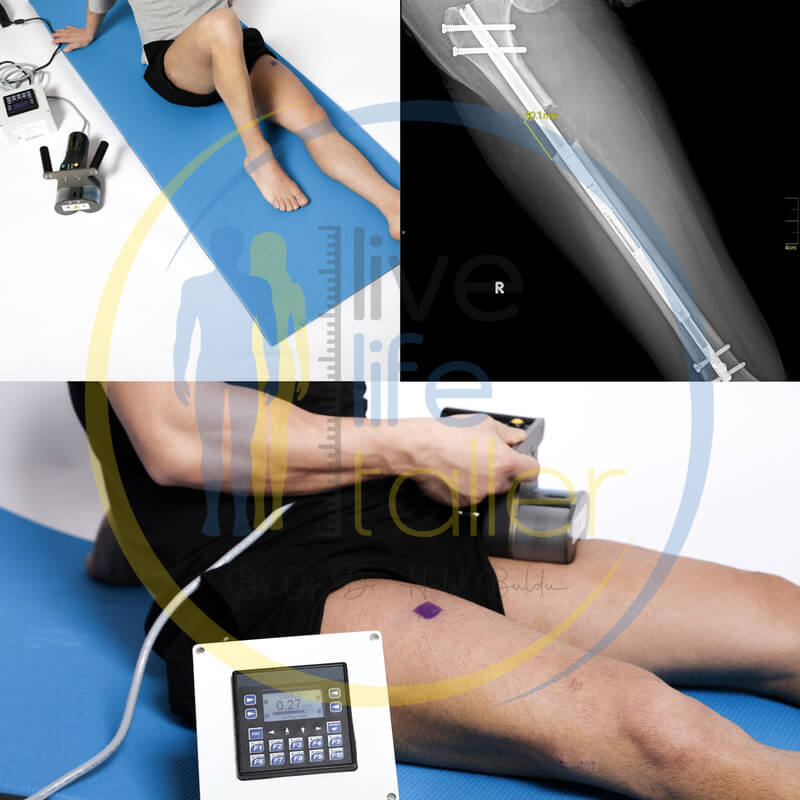
Will Lengthening Hurt?
Lengthening with the ERC is so gradual that nearly all of our patients have told us that their leg does not hurt during the lengthening sessions.
Is the Precice 2 System Suitable for Everyone?
The Precice nail is offered in several lengths and diameters, but a person’s bone may still be too small for it. The diameter of the bone must be wide enough so that the Precice can fit inside the bone canal. The doctor will measure the diameter of the bone on an X-ray. The Precice is offered in three diameters: 8.5, 10.7 and 12.5 mm (0.33, 0.42, 0.50 inches).
The bone also needs to be long enough to fit the Precice. The shortest nail is 6.3 inches (160 mm) for the tibia and 6.7 inches (170 mm) for the femur. The doctor will measure the length of the bone on an X-ray to see if it is long enough to accommodate the Precice nail.
Another factor is whether the ERC can be placed close enough to the Precice to make it lengthen. Soft-tissues (muscle, fat, skin) can be so thick that the ERC cannot be placed close enough to the Precice to activate lengthening. To see if the Precice will work for a patient, the doctor will measure the distance from the bone canal to the skin on an X-ray.
People are not good candidates for the Precice if they have a pacemaker or know that they will need an MRI scan in the next year. It is generally not recommended to have an MRI scan when a person has a Precice nail implanted. Therefore, we routinely recommend removal of the Precice about one year after surgery, provided that the lengthened bone is fully healed.
What about using the Precice in children?
A Precice nail may be inserted in a child’s thigh bone (femur) starting at about age eight years. For the shin bone (tibia), it is preferable to wait until close to skeletal maturity (age 14 years in girls and age 16 years in boys).
How much will the Precice lengthen a bone?
The bone is lengthened in very small amounts each day until the lengthening goal is achieved. The maximum amount that can be lengthened depends on which model of the Precice is used. Different Precice models can lengthen the bone a total of 1.2 inches (30 mm), 2 inches (50 mm) or 3 inches (80 mm). For example, if the shortest Precice is the only one that fits in the bone, the patient may be limited to lengthening a total of 1.2 inches. In most cases, we can implant the models that allow 2 to 3 inches of length.
What should be done to prepare for surgery?
Please visit our “Before Surgery” section for detailed information.
During the visit with the doctor, ask for our guide to prepare for surgery. When planning for Precice surgery, you should also be aware of the following:
- Schedule any necessary MRI scans before surgery: The patient may not be allowed to have an MRI scan after the Precice is inserted. An MRI scan could de-magnetize the Precice nail, making it unable to lengthen.
- Learn about the precautions that should be taken with the ERC: If any family members have a cardiac pacemaker, the ERC will need to be kept away from them. The magnet in the ERC could affect the functioning of some pacemakers. The magnet in the ERC can also adversely affect items such as credit cards, magnetic room keys and cell phones.
- Prepare for the ERC to be loud: When the ERC is being used to lengthen, it is loud! Parents may want their children to become familiar with the sound before the surgery. Watch this video to hear what it sounds like when the ERC is being used to lengthen the Precice.
How is the Precice inserted during surgery?
The doctor needs to make space for the device to fit inside the bone. The outer part of a bone is made up of hard tissue, but the inside of a bone is made up softer marrow tissue. The doctor will use an orthopedic drill to create a canal in the marrow cavity in the center of the bone. This canal will be large enough for the Precice to fit inside it.
The way the Precice is inserted depends on the bone and the patient’s unique situation:
- For the femur (thigh bone), the device may be inserted in two different ways: One way that the Precice can be inserted is through the top of the femur that is closest to the hip. This insertion from the hip towards the knee is called antegrade insertion. The illustration below shows how the nail is inserted, the skin incisions that are made, and where the bone may be cut (osteotomy) and lengthened. You can also find a video animation of this surgical technique here.
- Another way that the Precice can be inserted is through the bottom of the femur that is closest to the knee. This insertion from from the knee towards the hip is called retrograde insertion. The illustration below shows how the nail is inserted and the locations of the skin incisions and bone cut (osteotomy). Note that the location of the magnet in the femur when the Precice is inserted retrograde is different than when the Precice is inserted antegrade. The location of the magnet will affect where the patient places the ERC on the thigh. When the ERC is turned on and placed against the skin of the thigh, it causes the Precice to slowly lengthen.
- For the tibia (shin bone), the device will almost always be inserted from the top of the tibia that is closest to the knee. The illustration below shows how the nail is inserted, the skin incisions that are made, and where the tibia and fibula may be cut (osteotomy) and lengthened. You can find a video animation of this surgical technique here.
- For the humerus (upper arm bone), the device will be inserted through the top of the humerus that is closest to the shoulder (from the shoulder towards the elbow).
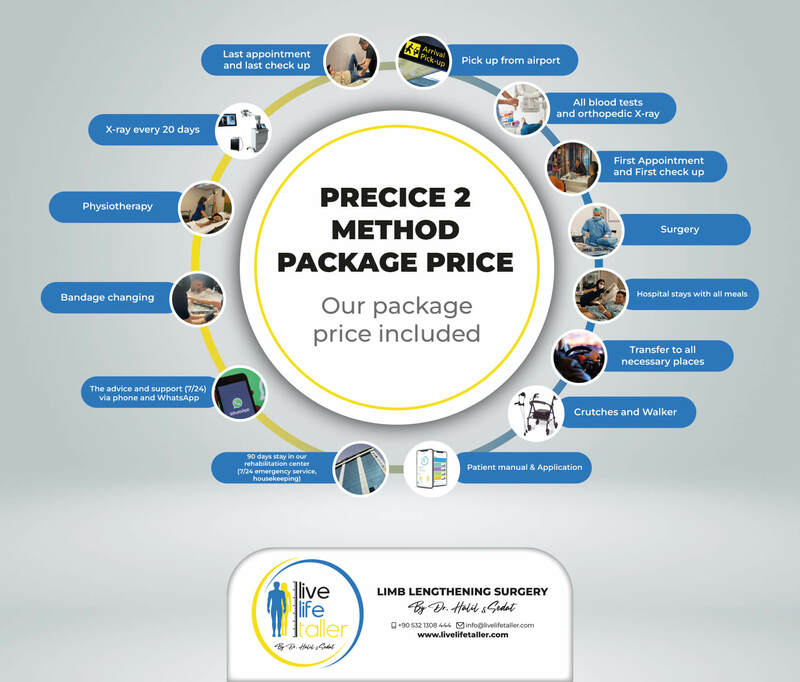
Cost of Limb Lengthening Precice2 method?
The cost of Precice 2 method surpasses that of the LON method, primarily due to the utilization of advanced technology and specialized equipment. In the LON method, intramedullary nail is secured with an external fixator. Conversely, the Precice Nail employs the ERC device for lengthening without requiring an external apparatus, resulting in fewer scars- an advantage that contributes to its aesthetic appeal.
In addition to minimising scarring, the Precice 2 method offers several advantages, including improved comfort in various sleeping positions. Taking all these factors into consideration, the price disparity between the LON method and the Precice 2 method can be attributed to these distinctive features.
What should be taken into consideration after Precice 2 method?
After the Precice is inserted, the patient will stay in the hospital for 2 to 3 days. Our doctors prefer that the patient stays in the Baltimore area for at least the first 2 weeks after being discharged from the hospital. While using the ERC to lengthen the Precice (called the distraction phase), the patient will need to return to the ICLL dor post-operative visits approximately every 10 to 14 days. After the distraction phase of treatment is completed, the consolidation phase starts where the bone solidifies and heals. The patient will need to return to the ICLL every month until the bone is healed.Physical or occupational therapy is critical during the distraction and consolidation phases of treatment. During therapy, the muscles, tendons and ligaments are stretched in order to ensure that the arm or leg will have full movement after treatment. Patients will need physical therapy if they are lengthening the bones in the legs or occupational therapy if they are lengthening the humerus (upper arm bone). Our doctors may or may not allow this to be done in the patient’s home town, since some people need more specialized physical therapy, which is available at our center. If patients require specialized physical therapy, they will need to stay in Baltimore for that period of time. In many cases, we also prescribe special braces/splints. These are generally made for the patient during the week after surgery.
The patient will be allowed only limited weight bearing on the leg with the Precice in it. The doctor will determine how much weight bearing is allowed on the leg based on each unique situation and the size of the Precice nail that is implanted. If both legs will be lengthened, the patient will need to be in a wheelchair.
Please talk to the surgeon if the patient needs to visit the dentist for routine cleaning or dental surgery during treatment. After the Precice is inserted, special antibiotics may be necessary in order to have dental work.
How is the ERC used to lengthen the bone?
When the ERC is turned on and placed against the skin of the leg or arm, it causes the Precice to slowly lengthen. When the Precice lengthens, the bone also lengthens. The ERC will stop when the patient has completed the correct amount of lengthening for that session.
When the arm or leg is swollen or has thick soft tissues, the doctor may instruct the patient to place the ERC against the skin and apply pressure to compress the soft tissues so that the ERC is closer to the Precice. Magnets work better when they are closer. Panel A and B below shows MRI scans of a cross section of a thigh. The red arrow in panel A shows the distance between the ERC and the center of the bone (where the Precice would be inserted). In panel B, the skin and soft tissues are compressed so that the distance between the ERC and the Precice would be reduces (the red arrow in panel B is shorter than the red arrow in panel A).
How often will the patient need to use the ERC?
The surgeon will prescribe how many separate lengthening sessions need to be done each day and the amount of lengthening for each session. Typically, patients are asked to lengthen the bone 0.75 to 1 mm each day (0.03 to 0.04 inches; there are 25 mm in 1 inch).
For example, a patient could be asked to lengthen 0.25 mm during four different sessions throughout the day, which would result in a total of 1 mm of lengthening each day. Each session with the ERC would takes about 2 minutes to lengthen the bone 0.25 mm. Four sessions would take a total of 8 minutes per day.
When can the Precice be removed?
Typically, the Precice is removed approximately 1 year after insertion. The removal procedure is an outpatient surgery, which means that the patient does not need to stay in the hospital overnight after the removal. The lengthened bone should be fully and circumferentially healed before considering removal of the Precice.
FAQ
Does Precice 2 method wounds heal faster?
Yes, Precice 2 method stitches heal more quickly compared to LON method stitches, as they result in aesthetic wounds. The wounds are minimal and aesthetic, healing within average of 3 to 6 months.
Is Precice 2 method surgery painful?
The surgery itself not painful because the patient will be under general anaesthesia. After the surgery, the patient may feel a little uncomfortable until the effect of general anaesthesia wears off. Although the body’s reaction to surgery is different for everyone, our team will be with you at the hospital to minimize this.
How many cm taller can you grow with the Precice 2 method?
Precice nails have a limit for lengthening, it can lengthen maximum 8 cm.
Who is Precice 2 method surgery suitable for?
The diameter of the bone must be wide enough so that the Precice can fit inside the bone canal. The doctors will measure the diameter of the bone on an X-Ray. The Precice is offered in three diameters: 8.5, 10.7 and 12.5 mm (0.33, 00.42, 0.50 inched)
Can the Precice 2 method be applied to children?
A Precice nail may be inserted in a child’s thigh bone (femur) starting at about age eight years. For the shin bone (tibia), it is preferable to wait until close to skeletal maturity (age 14 years in girls and age 16 years in boys)
How does the process continue after Precice 2 surgery?
After the Precice nail inserted, the patient will stay in hospital for 2 to 3 days. After the doctor decides for them to discharge, the patient can be discharged from the hospital. Approximately 1 week after the surgery, the patient can start lengthening. During the lengthening phase, the patient needs to support the process with physical therapy sessions daily.
How many days is the recovery period for the Precice 2 method?
It depends on a few things like how many cm you want, how much your muscles get tight during the lengthening, your gender and you bone healing, etc… The exact amount of time can’t be given but usually in 3 months, you can walk and do your activities normally. It can be 3-6 months. Full recovery is after the intramedullary nail removal when your bone totally heals.
